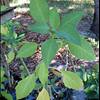This plant may be available to buy
Click the banana to see

|
Why Are My Plant's click pics to enlarge |
|
There are 9 possible reasons why 1. The "Good News" reason is that leaves naturally turn from green to yellow then brownish and dry and shriveled All plants? Yes In the two pictures at the top, each of the yellow leaf areas are the lower, OLDER leaves whose time is over. Nature re-captures the nutrients from the old leaves into the main plant and the leaf color becomes yellow What to do? Nothing, except relax, Nature is in control 2. Sudden unexpected cold If a plant is used to suitable conditions then cold comes in, leaf yellowing and leaf drop is common What to do? Usually nothing, except with potted plants. If you expect more cold, shelter your plant indoors in a warm, bright area where people are comfortable But ....you should have taken your plants to shelter well before the cold came in. Here is our article on how to successfully winterise your potted plants to bring indoors for the winter 3. Heat Many plants comfortable in moderate temperature conditions can "complain" by dropping leaves with ongoing excess heat. The time from green to yellow to drop can be very fast What to do? Consider if a better location is possible for this plant. For example, rather than a full sun location, a spot with afternoon shade could be your permanent solution 3. Too wet Too much water chokes roots and very often causes leaf yellowing In the case of potted plants, you control the water In the landscape, your sprinklers may need adjusting 4. Too dry If water is needed and not available, a plant can not "hold" all its leaves. In defense plants shed leaves. In this case the green to yellow to drop process can be very fast What plants want is consistent water for best growth and daily happiness. Of course, that amount varies by the variety of plant Plants which are native to swampy areas may need to be constantly moist to be happy, so ANY fall off in available water = instant leaf complaints (yellowing) On the other hand, our desert rose plants can go a long time between watering. Cactus and succulents in general require excellent drainage and no standing water, otherwise, you see yellow leaves and leaf drop 5. Your new plant suddenly is getting sick fast. Yellow leaves are developing rapidly and leaf drop is scary This situation is very common. We call this "decline" and yellow leaves are the first symptom. We have a separate article on this subject 6. A change of location Virtually 100% of the time, if you move a plant to a new location, you will see leaf yellowing. Unless the new location is more suitable than the old location, your plant needs to adjust/adapt to the new location so leaf yellowing is part of the process For example, if you move a plant into more sun, the leaves may be stressed. The plant "knows" the current leaves can't withstand the increase in sun sun and so, in defense, grows new leaves that can handle the new exposure Moving to a location with less light//sun/hours/intensity, the plant can no longer "hold" the same amount of leaves so starts to shed leaves trying to balance light and leaf quantity 7. Fertilizer, especially liquid chemical fertilizers Folks tend to use fertilizers in excess. Too much fertilizer, especially liquid chemical fertilizers, create a toxic situation and rapid leaf yellowing (burn) is the result Fertilization is a very important subject and so we have a separate article on fertilization 8. Disease There is virtually no technology for plant diseases. Scientists study causes but the "cures" side of the equation is almost zero Your best defense is promoting plant health especially with proper feeding 9. Damage Improper maintenance, often via your lawn man, can cause plant damage, like when using a weed whacker. You may not see (because you don't look closely) where equipment may have hurt your plants. Be sure you know how to manage your lawn man for starters Damaged plants may be able to heal themselves. You may be able to do some pruning to assist. The main point is to avoid the damage in the first place |

